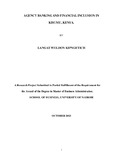| dc.description.abstract | Agent banking has become one of the most promising strategies for offering financial
services to the poor and underserved. In this model, financial institutions work with
networks of existing nonbank retail outlets to deliver financial services. This approach
is especially powerful when serving the unbanked poor because or its ability to reduce
banks' cost-to-serve and reach low-income customers where they live. This
alternative banking channel has increasingly gained importance in developing
countries over the last decade. The extent to which agency banking can be used as a
tool for broadening financial inclusion remains largely unknown. This study aimed at
assessing the impact of agent banking services in reducing transactional costs,
mitigating risks and enhancing financial inclusion. The study explored the role of
agent banking in broadening financial inclusion to both banked and unbanked. It
intended to probe how commercial banks were responding to risks like fraud and
insecurity which result from this innovation. This study sought to assess the impact of
agency banking in enhancing financial inclusion in Kenya. Descriptive survey design
was used in conducting this study. This involved collection of information by
administering a questionnaires and interviewing to a sample of individuals. The
design was appropriate because it allowed the researcher to describe record, analyze
and report conditions that exist. The study population involved all commercial banks
in Kisumu that had been approved by Central Bank of Kenya (CBK) to roll out agent
banking. The data collected was edited to minimize errors, coded and entered into an
access database. Descriptive methods were used to analyze the qualitative data while
Statistical Package for Social Scientists (SPSS) was used to analyze quantitative data.
The results of the study were presented through tables, charts and graphs in a
continuous prose form. The study found that agency banking cash withdrawal; deposit
and accounts opening were the most commonly used services. Further, the study
found that the business model was not self- sustaining and required that it be hinged
to another business. It recommends that agents should be allowed to offer a wider
array of services including balance enquiries, bills payment and loan appraisal. The
principal bank should support the agents so as to generate adequate income by way of
dedicating some services, such as payment for utilities, to be exclusively offered by
agents. The regulating body should control the proliferation of many agencies in a
locality to ensure profitability. The physical distance from one agent to the other
should take into consideration the population of the area so as to enhance financial
inclusion. | en_US |

